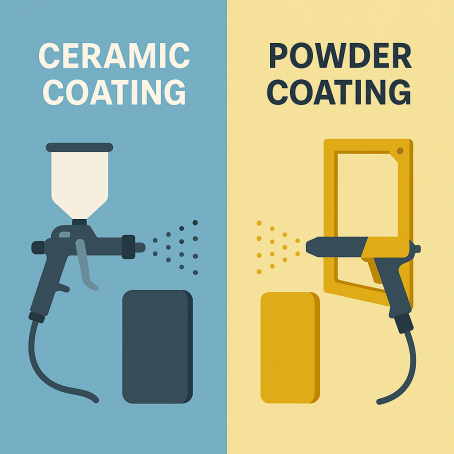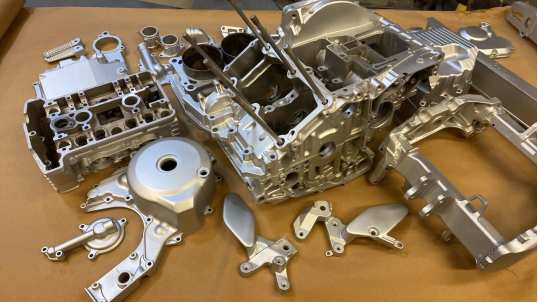Ceramic Coating vs Powder Coating: Difference & Application in Precision Parts
 Apr 02,2025
Apr 02,2025

It is desired that precision parts should last longer and exhibit better surface properties. Coatings like powder coating and/ or ceramic coating shield the precision parts from atmospheric impacts like corrosion, heat, scratches etc. These coatings enhance the tribological performance in several ways like reduction in friction, resistance to scratch, resistance to corrosion and heat. These coatings also make precision parts more aesthetically pleasing. Let’s find out more about ceramics coating vs powder coating.

What Are Precision Parts?
Precision parts are critical components of a machine requiring tight dimensional tolerances and strict compliance with the engineering design. The parts are often required in advanced industries like aerospace, automobiles, medical implants and complex machinery.
What Are Ceramic and Powder Coatings?
Ceramic coating and powder coating are surface coating over substrates to boost up their tribological behavior. They also enhance the aesthetic appearance.
Why Coating Precision Parts Matters
Precision parts gain longevity in the service life after surface coating. A few examples would be given in later sections to give a better understanding to our readers.
What Is Ceramic Coating in Precision Parts
Ceramic coating deposits a thin, hard and brittle layer of inorganic compounds like silica, titania, alumina etc. onto substrates. The compounds give an electrical and thermal insulative character to the metal surface. They also improve the tribological behavior and aesthetics to precision components.
How Ceramic Coating Works on Precision Parts
The Ceramic Coating Process for Metals
A thin layer of resin containing fine ceramic particles is sprayed or applied by doctor blades onto metal surface. It is then left to cure for a specified time. An elevated temperature might also be required. Please see the below link showing real world applications od ceramic coating:
Benefits of Ceramic Coating for Precision Parts
Ceramic coating brings a lot of benefits like, resistance to scratch, resistance to heat, non-conductive surfaces, less friction, less need for lubrication and aesthetic appeal.
Heat Resistance and Longevity

Consider an example. Pistons in an engine block coated with a ceramic layer would have a lower surface friction and high resistance to heat. It not only increases the component life but also reduces the requirement for lubrication.
Chemical and Scratch Resistance
As ceramic particles are non-reactive to many environments, they make the surface highly corrosion resistance. A high hardness makes the surface resistance to scratches.
Drawbacks
Ceramic coatings often make chemical bonds with the underlying surface. It is a bit hard to remove and it can damage the surface upon removal.
What Is Powder Coating in Precision Parts
Powder coating is the application and curing of polymer compounds over the metal surface. This layer is thicker and harder than a paint layer. This powder coating layer imparts corrosion resistance and aesthetic appeal on precision parts.
The Powder Coating Process Explained

Application Methods for Powder Coating
- Electrostatic Spray Deposition (ESD)
A fine polymer powder is ejected from an electrically charged nozzle. The metal surface is given an opposite charge. The deposited polymer layer is allowed to set under heat. Please visit the link to know more:
- Fluidized Bed Application
In this method the precision part is immersed in a fluidized bed of fine polymer powder. The coated part is then baked in a oven.
|
Feature |
ESD (Electrostatic Spray Deposition) |
Fluidized Bed |
|
Method |
Powder sprayed with electrostatic charge |
Heated part dipped in powder bed |
|
Coating Thickness |
Thin to medium (25–100 µm) |
Thick (250–500 µm) |
|
Best For |
Automotive, appliances, furniture |
Heavy-duty parts, pipelines, racks |
|
Finish |
Smooth, even |
Thick, durable |
|
Heat Requirement |
Curing after application |
Pre-heating before dipping |
Advantages of Powder Coating for Precision Parts
A powder coated component would be more aesthetically pleasing and less prone to corrosive attack than an uncoated component.
Durability, Thickness, and Finish Quality
In contrast to a normal paint layer, polymer layer is thicker, more adhesive and uniform is color and finish.
Chemical and UV Resistance
Polymer are often non-reactive to common chemical environments. Hence a metal surface would also enjoy these benefits. Although UV rays do not degrade the bulk of the powder coating but discoloration might occur.
Disadvantages
Powder coating is deemed as permanent. Unlike paint, it is difficult to remove to change color.
Ceramic Coating vs Powder Coating: Key Differences in Precision Parts
Check out the below table for a Ceramic vs Powder Coating Comparison:
|
Feature |
Ceramic Coating (Protective) |
Powder Coating (Color Finish) |
|
Purpose |
Heat and chemical protection |
Decorative and corrosion resistance |
|
Thickness |
Thin (2–20 µm) |
Thick (50–150 µm) |
|
Durability |
Very High |
High. but can chip |
|
Heat Resistance |
Excellent (800–1,000°C) |
Moderate (≤250°C) |
|
Corrosion Resistance |
Excellent |
Good |
|
Chemical Resistance |
High |
Moderate |
|
Surface Finish |
Clear or semi-transparent |
Wide range of colors & textures |
|
Cost |
High |
Moderate |
|
Best For |
Automotive exhausts, aerospace, industrial parts |
Furniture, automotive frames, appliances |
Coating Performance on Different Materials
Ceramic VS Powder Coating on Metals
Metals are excellent substrates for both ceramic and powder coating applications. Coating process is relatively easy and bonding between substrate and coating is also good.
Ceramic VS Powder Coating on Plastics
Ceramic Coating provides protection but has adhesion challenges on plastics. Powder Coating is unsuitable due to high curing temperatures.
Application Scenarios and Industry-Specific Uses
There are many applications of ceramic and powder coatings in the industry. A common scenario can be comparison of ceramic coated vs uncoated Aluminum 6061 grade. Uncoated aluminum cannot withstand the high heat generated in a car engine. Whereas, a ceramic coated aluminum part can serve for many years inside a car engine. Check out below table for common industry specific uses:
|
Application |
Powder Coating |
Ceramic Coating |
|
Automotive |
Frames, wheels, bumpers |
Exhausts, pistons, turbochargers |
|
Aerospace |
Interior panels, brackets |
Turbine blades, heat shields |
|
Industrial |
Machinery, enclosures |
Cutting tools, wear parts |
|
Marine |
Railings, boat hulls |
Propellers, engine parts |
|
Electronics |
Casings, heat sinks |
Circuit boards, high-heat parts |
|
Medical |
Equipment frames |
Surgical tools, implants |
|
Outdoor |
Fences, furniture |
High-temperature structures |
Robotics, Drones, and Emerging Technologies
Piezoelectric, ferroelectric and ferromagnetic ceramics on precision components can impart sensing and actuating functions on them.
How CNC Machining Plays a Role in Coating Precision Parts
CNC machining can help in ensuring tight dimensional tolerances in precision parts. A coating will help to maintain it. For instance, powder coating will prevent buildup of rust, thus the dimensions will remain the same. Ceramic coating can help to prevent dimensional changes by withstanding erosion and wear.
CNC Machined Precision Parts Suitable for Coating
Types of CNC Machined Parts That Benefit from Ceramic and Powder Coatings
- Structural Components: Machine frames, brackets, and automotive chassis can be powder coated to enhance aesthetics and durability.
- Wear-Resistant Parts: Moving parts likegears, cutting tools, and industrial bearings is ceramic coated will withstand wear resistance.
- High-Temperature Parts: An insulative ceramic layer can acts as a thermal barrier for pistons in the engine block.
- Corrosion-Prone Parts: Both ceramic coating and powder coating are non-reactive. They prevent corrosion in metals to a big extent.
How to Choose Coating for Precision Parts
The choice solely depends on the intended applications. Requirement of high heat resistance, wear protection, and chemical durability can be met by ceramic coatings. Powder coating provides aesthetic appeal, corrosion resistance, and a uniform finish.
Purpose and Application Requirements
When To Apply A Ceramic Coating?
A ceramic coating is need to enhance the heat resistance, wear protection, and chemical durability. For instance, the life of a cutting tool can be enhanced manifold by coating it with ceramics.
When To Apply A Powder Coating?
Powder coating improves characteristics like corrosion resistance, durability, and aesthetic enhancement. As an example, an automotive frame can look aesthetically pleasing and durable for the complete service life by powder coating it.
Cost Considerations
Powder coating is easier to apply and relatively inexpensive. Ceramic coating is bit more expensive.
Aesthetic and Finish Quality
Both ceramic coating and powder coating provide good surface finish and aesthetic appeal. Powder coating can fade overtime on exposure to UV rays. Ceramic coating is a bit more resilient.
Conclusion:
Coating precision parts with either ceramic or powder can be desirable in many circumstances. It not only enhances surface finish and aesthetics but also imparts corrosion resistance and durability. The choice between ceramic coating and powder coating solely depends on the intended applications. For an expert opinion, consult relevant industry standard and professionals.
FAQ
Can Ceramic Coating Be Applied to All Types of Precision Parts?
Almost all precision parts can be ceramic coated.
What Makes Powder Coating More Durable for Metal Parts?
Powder coating provides a non-reactive layer over the metal surface which prevent corrosion.
Which Coating Offers Better Performance for High-Temperature Parts?
Ceramic coating can be an excellent choice for high temperature applications.
What Are Most Common Used Colors When Powder Coating?
Common powder coating colors include black, white, gray, red, blue, silver, metallics, green, and beige.
 Tel/WeChat:
Tel/WeChat:  Email:
Email: 
 Home
Home
 Types of Gears: Designs, Applications & Robotics Integration
Types of Gears: Designs, Applications & Robotics Integration 







